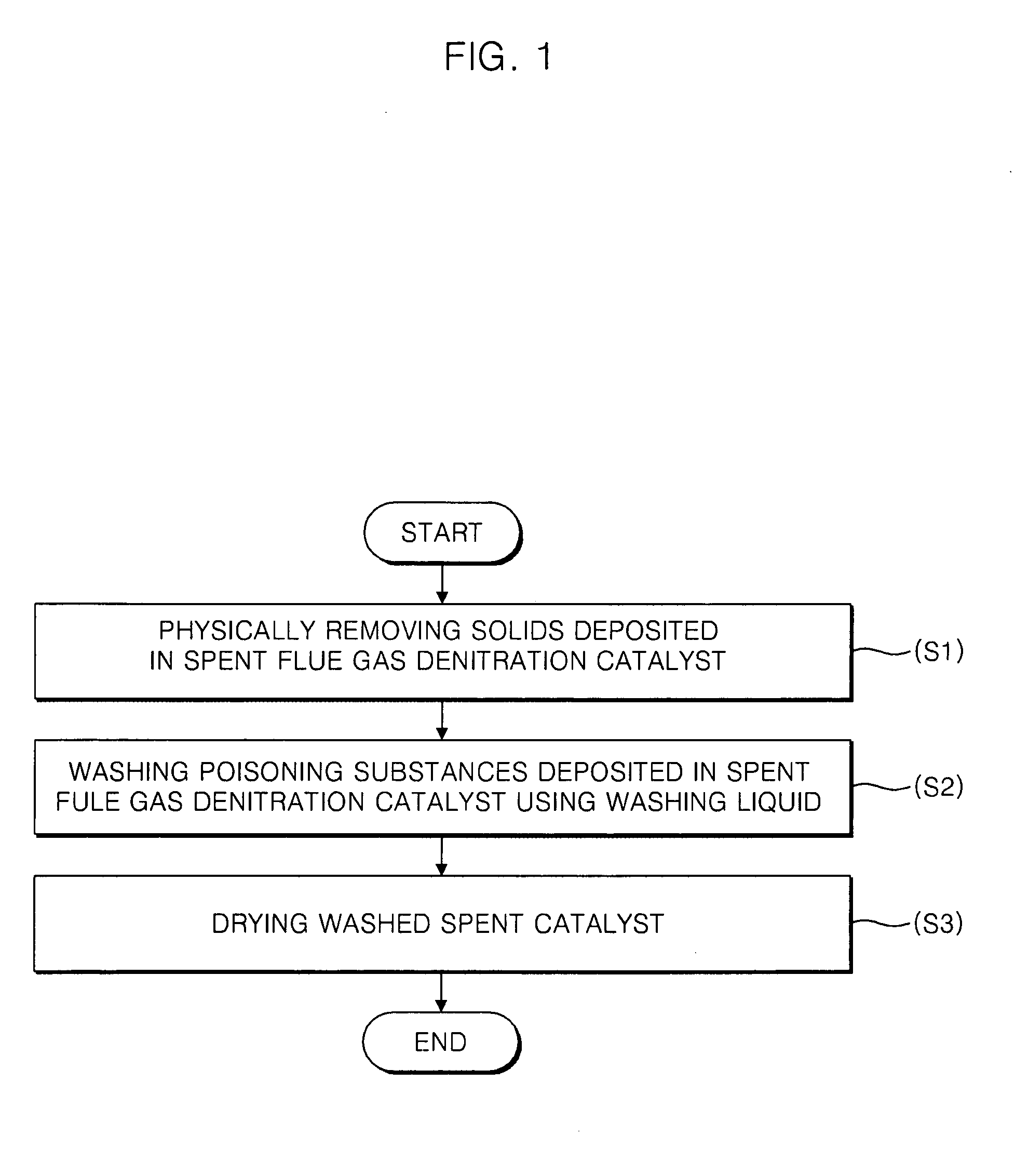Method of recycling spent flue gas denitration catalyst and method of determining washing time of spent flue gas denitration catalyst
a technology of denitration catalyst and flue gas, which is applied in the direction of other chemical processes, instruments, separation processes, etc., can solve the problems of not revealing any method of calculating a washing time, requiring a large amount of manpower and equipment, and taking a long time to carry out analysis, etc., to achieve low cost, low cost, and low cost
- Summary
- Abstract
- Description
- Claims
- Application Information
AI Technical Summary
Benefits of technology
Problems solved by technology
Method used
Image
Examples
experimental example 1
Change in Hydrogen Ion Concentration According to Washing Time
[0044]The spent catalyst used in this Experimental Example was one that was used in flue gas denitration equipment of a thermal power plant for a long period of time such as 1,300 hours and had a denitrification efficiency lowered to about 58% at a temperature of 350° C. The above catalyst was a commercially available catalyst having a 20 cell-per-square-inch (CPSI) honeycomb structure and prepared by supporting V2O5 and WO3 on a titanium dioxide carrier. The test catalyst was made into a granule having a size of 30 mm in length, 30 mm in width and 45 mm in height and immersed in distilled water of 1,000 ml so that the poisoning substances were eluted for 60 minutes. Here, the hydrogen ion concentrations with the passage of time were measured and shown in FIG. 3. It can be seen from FIG. 3 that the hydrogen ion concentration becomes nearly constant after 10 minutes.
experimental example 2
Elution Amounts of Poisoning Substances According to Washing Time
[0045]The elution amounts of the poisoning substances such as Ca, K, Mg, Na, P, S and V according to the washing time in the catalyst and washing liquid, the same as those in Experimental Example 1, were analyzed using an inductively coupled plasma atomic emission spectrometer. FIG. 4 shows the elution amounts of the poisoning substances according to the washing time. It can be seen from FIG. 4 that the elution amounts of most poisoning substances become constant within about 10 minutes from the beginning of the washing process. These results are the same as those obtained from the measurement of the hydrogen ion concentrations according to the washing time. Accordingly, it can be understood that the time when the poisoning substrates are eluted, i.e., the washing time, can be calculated through the measurement of the hydrogen ion concentration in real time without using complicated equipment such as the inductively co...
experimental example 3
Denitrification Rates of Catalyst According to Washing Time
[0046]Under the same conditions as Experimental Examples 1 and 2, the denitrification rates of the catalyst were measured by varying the washing time. In this Experimental Example, the conditions for the measurement of the denitrification rates are shown in the following Table 1:
TABLE 1Reaction temperature400° C.Space velocity20,000 / hrMolar ratio of ammonia / nitrogen oxide1.0Nitrogen oxide500 ppmSulfur oxide500 ppmOxygen5%
[0047]The denitrification rates according to the washing time obtained from the above measurement are shown in the following Table 2. It can be understood from Table 2 that the regeneration efficiency of the catalyst is increased until 10 minutes in the washing process and then there is no change in the regeneration efficiency although the washing time is increased.
TABLE 2Washing timeDenitrification rate 0 minutes58.0% 4 minutes66.2%10 minutes78.3%20 minutes79.0%30 minutes78.5%60 minutes78.6%
[0048]It can be ...
PUM
| Property | Measurement | Unit |
|---|---|---|
| temperature | aaaaa | aaaaa |
| temperature | aaaaa | aaaaa |
| temperature | aaaaa | aaaaa |
Abstract
Description
Claims
Application Information
 Login to View More
Login to View More - R&D
- Intellectual Property
- Life Sciences
- Materials
- Tech Scout
- Unparalleled Data Quality
- Higher Quality Content
- 60% Fewer Hallucinations
Browse by: Latest US Patents, China's latest patents, Technical Efficacy Thesaurus, Application Domain, Technology Topic, Popular Technical Reports.
© 2025 PatSnap. All rights reserved.Legal|Privacy policy|Modern Slavery Act Transparency Statement|Sitemap|About US| Contact US: help@patsnap.com



